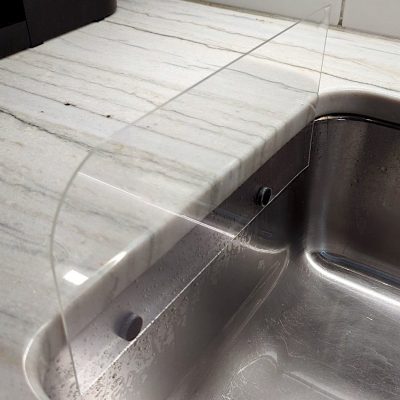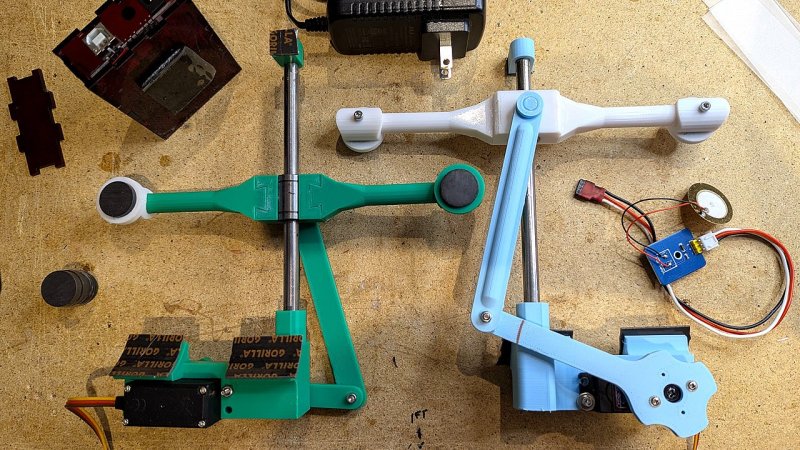If you’re blessed with high water pressure at home, you probably love how it helps blast grime from your dishes and provides a pleasant washing experience. However, it can also cause a wonderful mess when that water splashes all over your countertops. [vgmllr] has whipped up a simple solution to this problem by installing an automatic splash guard.

The concept is simple enough—install a pair of flat guards that raise up when the sink is running, in order to stop water getting everywhere. To achieve this, [vgmllr] grabbed an Arduino, and hooked it up to a piezo element, which acts as a water sensor.
The piezo is attached to the bottom of the sink, and effectively acts as a microphone, hooked up to one of the Arduino’s analog-to-digital pins. When water flow is detected, the Arduino commands two servos to raise a pair of 3D printed arms that run up and down the outside of the sink. Each arm is fitted with magnets, which mate with another pair of magnets on the splash shields inside the sink. When the arms go up, the splash shields go up, and when the arms go down, the splash shields go down.
It’s an ingenious design, mostly because the installation is so clean and seamless. By using magnets to move the splash shields, [vgmllr] eliminated any need to drill through the sink, or deal with any pesky seals or potential water leaks. Plus, if the splash shields are getting in the way of something, they can easily be popped off without having to disassemble the entire mechanism.
It’s a tidy little build, both practical and well-engineered. It’s not as advanced as other kitchen automations we’ve seen before, but it’s elegant in its simple utility.
















Neat!
“simple”
It’s very cool, don’t get me wrong. But that’s definitely not the word I would choose.
“Simple” == “Goldbergian”, right? =))
It’s an actuator that moves an arm when it detects ADC input noise over a threshold on an elderly 8 bit microcontroller with ~50 lines of code including bracket lines. Is that not simple enough for you? What would be simple enough, plugging in an LED and running blink?
I would agree the mechanical build is “not simple” for your average electrical hacker, but it’s really not complex either. Freshman mechanical engineers make way more complex things, and I would still consider those “simple”.
That said I think the article describes it as simple largely because the UX is so elegant. No buttons, no switches, the shield moves on its own and is super easy to detach and reattach. It’s a very elegant solution in many ways.
I have a feeling it is very noisy though and it will leave marks on the sink, but honestly this is the kind of thing that has enough product and industrial design thought that I expect the author is a professional in a related field.
Awesome build though, I’m surprised I haven’t seen something similar on high end sinks before, though I guess the people that can afford this kind of stuff in uber expensive Kohler form or whatever have dishwashers and paid help.
Super cool hack, it’s so rare we get to see a simple hack that is also elegant and has an excellent UX.
Simple would be the plastic splash guard running in small 3d printed tracks on the edge of the counter. Slightly more complicated but keeping the clean look, splash guard with magnets on it, and magnets on the other side holding it there, and some 3d printed tracks on those to hold them there if you remove the guard entirely. Pull it up when you need it, push it down when you’re done. Or you can have two sets of magnets, one high and one low, fixed in place, alleviating the “scraping magnets on your sink surface” issue. Bonus feature, the guard can be in place before water starts flowing and potentially splashing, instead of being reactionary. No microcontroller or code necessary. Not even a 555. But it wouldn’t make it on HaD.
I agree this is really well built, and simple usage once built. I don’t begrudge anyone wanting to do this. I just said I wouldn’t use the word simple to describe this solution.
Simple enough would be just using less water so it doesn’t spray everywhere.
Simple is an inline pressure reduction washer, like the one that came with our last kitchen tap…
But this is very cool.
Came here to say something similar. Excessive pressure wreaks havoc on plumbing systems. A whole house pressure reducer saves wear on the plumbing and achieves the same effect more simply. It’s a cool project but a little too Rube Goldberg.
Or just lifting the flap by hand before you open the tap, so you avoid the initial splash of water as well.
Like this one a lot.
Fore years I’ve been wishing for something that turns a normal kitchen sink into something almost like a sandblasting cabinet.
Not necessarily with the gloves and stuff == maybe with the front part missing.
And of course a faucet(?) hose(?) with a nozzle that is a bit like the ones from power washers (a single line).
Have you seen the rabbit r1, humane ai pin, or the “friend” necklace?
You clearly haven’t seen aftermath after me washing the dishes. I’m taking almost as much time drying around the sink afterwards as doing the dishes.
hahah i hope i’m using this phrase right
“sounds like a skill issue to me”
Get a squeegee and use that.
Get a dishwasher.
Or children.
A squeegee works and is cheap and easy.
And single people don’t need dishwashers, and even large families with dishwashers aren’t going to use it for one quick small cleaning of a single item. You end up wasting money on dishwasher soap.
And dishwashers need to have maintenance too btw, you have to clean it out from time to time, and who needs that hassle?
You don’t HAVE to use clear plastic, you can use any plastic you want, or even use a rustproof metal.
Also when the thing is down, in the sink, it should be easy to rinse off right?
Neat idea, but why all the rigamarole with a sensor, actuator, microcontroller, software and electrical supply? Just put a hydraulic cylinder in, powered by the water pressure itself. Gravity return. No muss, no fuss.
I SO wish someone invented a sort of a valve specifically for the purpose of reducing pressure.
Srsly? In what alternate timeline do you live that has not had pressure regulators for the last century or more?
Autism-level sarcasm recognition.
Wink, wink …
Good solution in theory. But this solution has 0% of causing a water leak, whilst yours does have a small risk causing a leak.
How are you going to tap into the water line AFTER the sink valve? Fixtures typically don’t have a provision for that.
True, that would be a challenge to those not able or willing to drill and tap a hole in the appropriate place.
And I assume your cognitive normal and well adjusted.
Yes, comment system clearly broken.
They prefer the term ‘adventurist’
I may be missing something, but why not just keep the guard up all the time?
It gets in the way?
Nice toy. But usefull in the kitchen.
let me guess. the tap uses a lever to open and close it in the horizontal direction an sets the temperature in the vertical. those need to die. they open to full blast in a pinch and you never know what is cold or hot, because of bad clean design we see way too often in “modern” kitches. “functionality? what has functionality to do with it? doesn’t it look gorgeous?”
this contraption is a band aid, not a fix.
So most people commenting on HaD never washed anything and think you can clean stuff and remove the soap with a weak stream of water it seems.
What do you consider “weak”? I’ve got 70 psi on my home system and don’t have a problem with excessive splashing or getting dishes clean. A little scrubbing does wonders.
Quite bizarre the effort gone to, just do what an ordinary sink with a raised wet-edge around it had been doing since before WW2.
Sunken-in sinks are the pits.
Unless combined with functional drains back into the sink.
Stone counters are for looking at, not working on.
Incompatible with knives or spilled food.
Amazing idea and clean execution! the magnetic panels are genius: they dryp dry in the sink and are easy to detach/clean, and all the delicate stuff is impossible to touch/get wet
I had to grab 2 hard drive magnets and test that this works thru stainless steel, quite well! I wouldn’t want the scratches on the sink but worst of all the between space of the panel getting spotted and filthy visible with hard water etc. It’s like leaving a plate on the side of the sink which never gets cleaned. I dry my sink so hard water doesn’t build up. It shines under the close LED lights even the chrome faucet base and handle. This shield does nothing for the biggest splash zone at any sink, the back area including faucet usually cluttered with cleaning aids all kept in the puddle of filth never cleaned off. I even know some who keep the kitchen knife behind the faucet.
Enough of handles we need fancy sensor valves or footles. Yeah it’s not a word. Should be required after all the germ scare of covid especially in public rest rooms.
A better application will be a sneeze detector connected to a face shield. And an alcohool pulverizer around you. And a tiny spark. Begone viruses!
I know that he did this because he could, but the question that is never asked is why make it in the first place. IMO, it’s easier to clean the counter and the side of the sink, than having to clean the back sides and the front sides of the splash guards and the sink behind it. Clear spastic will always show every scratch and water mark.